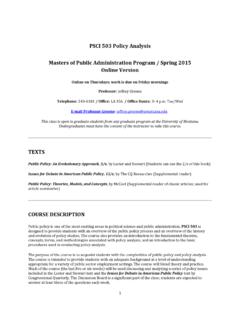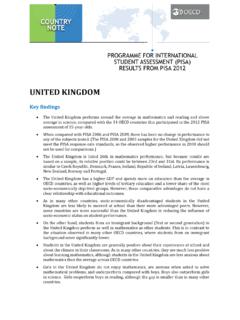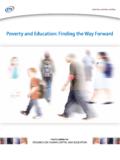Transcription of EDUCATION POLICY OUTLOOK BELGIUM - OECD.org
1 EDUCATION POLICY OUTLOOK BELGIUM September 2017 EDUCATION POLICY OUTLOOK : BELGIUM OECD 20172 EDUCATION POLICY PROFILE This POLICY profile on EDUCATION in BELGIUM is part of the EDUCATION POLICY OUTLOOK series, which presents comparative analysis of EDUCATION policies and reforms across OECD countries. Building on the OECD s substantial comparative and sectorial POLICY knowledge base, the series offers a comparative OUTLOOK on EDUCATION POLICY by providing analysis of individual countries educational context, challenges and policies ( EDUCATION POLICY profiles), analysis of international trends, and insight on policies and reforms on selected topics.
2 In addition to country-specific profiles, the series also includes a recurring publication. The first volume, EDUCATION POLICY OUTLOOK 2015: Making Reforms Happen, was released in January 2015. Designed for POLICY makers, analysts and practitioners who seek information and analysis of EDUCATION POLICY , taking into account the importance of national context, the country POLICY profiles offer constructive analysis of EDUCATION POLICY in a comparative format. Each profile reviews the current context and situation of the country s EDUCATION system and examines its challenges and POLICY responses, according to six POLICY levers that support improvement: Students: How to raise outcomes for all in terms of 1) equity and quality and 2) preparing students for the future.
3 Institutions: How to raise quality through 3) school improvement and 4) evaluation and assessment. System: How the system is organised to deliver EDUCATION POLICY in terms of 5) governance and 6) funding. Some country POLICY profiles contain spotlight boxes on selected POLICY issues. They are meant to draw attention to specific policies that are promising or showing positive results and may be relevant for other countries. This country profile also includes a spotlight on the European Union perspective for BELGIUM , based on challenges and recommendations identified by the Council of the European Union and the European Commission as part of their activities with EU member countries.
4 Special thanks to the Flemish Community, the French Community, and the German-speaking Community of BELGIUM for their active input during consultations and constructive feedback on this report. We also thank the European Commission for its valuable analytical and financial support for the development of 11 OECD-EU Country Profiles published from 2015 to 2017. Authors: This country POLICY profile was prepared by Gillian Golden (main drafter), Diana Toledo Figueroa, Manon Giovinazzo, Shiana Crosby and Michaela Horvathova from the EDUCATION POLICY OUTLOOK team, which is part of the POLICY Advice and Implementation Division, led by Paulo Santiago.
5 Editorial support was provided by Clare Rogers and C lia Braga-Schich. This profile builds on the knowledge and expertise of many project teams across the OECD Directorate for EDUCATION and Skills, to whom we are grateful. M nika K pe-Holmberg and Patricia de Smet contributed on behalf of the European Commission Directorate-General for EDUCATION and Culture. Sources: The EDUCATION POLICY OUTLOOK country profiles draw on OECD indicators from the Programme for International Student Assessment (PISA), and, where available, from the Survey of Adult Skills, of the Programme for International Assessment of Adult Competencies (PIAAC), the Teaching and Learning International Survey (TALIS) and the annual publication EDUCATION at a Glance.
6 They also refer to country and thematic studies such as OECD work on early childhood EDUCATION and care, teachers, school leadership, evaluation and assessment for improving school outcomes, equity and quality in EDUCATION , efficient use of school resources, governing complex EDUCATION systems, vocational EDUCATION and training, and tertiary EDUCATION . Much of this information and documentation can be accessed through the OECD EDUCATION GPS at BELGIUM s communities and regions may engage in these exercises all together or separately.
7 When relevant, this is specified in the text and in Annex B. Most of the figures quoted in the different sections refer to Annex B, which presents a table containing indicators for BELGIUM (as well as for the different Communities EDUCATION systems, where available), for the different sources used throughout the country profile. Hyperlinks to the reference publications are included throughout the text for ease of reading and also in the references and further reading section, which lists both OECD and non-OECD sources. More information is available from the OECD Directorate for EDUCATION and Skills ( ) and its web pages on EDUCATION POLICY OUTLOOK ( ), as well as on the EU EDUCATION and Training Monitor ( ) and Eurydice Publications ( ).
8 EDUCATION POLICY OUTLOOK : BELGIUM OECD 20173 TABLE OF CONTENTS Highlights .. 4 BELGIUM EDUCATION system snapshots .. 7 1. EDUCATION System of the Flemish Community .. 7 2. EDUCATION System of the French Community .. 9 3. EDUCATION System of the German-speaking Community .. 11 Equity and quality Almost universal participation in pre-primary EDUCATION .. 13 Preparing students for the future Varied links between EDUCATION , training and employment .. 15 School improvement Fostering better teaching and leadership .. 17 Evaluation and assessment to improve student outcomes High autonomy and trust in schools.
9 19 Governance A highly fragmented EDUCATION system .. 21 Funding High dependence on public funds .. 23 Annex A: Structure of the Flemish Community and French Community EDUCATION systems .. 25 Annex B: Statistics .. 27 References and further .. 30 Figures Figure 1. Student performance in science and impact of economic, social and cultural status .. 5 Figure 2. Upper secondary and tertiary attainment .. 5 Figure 3. Science performance and percentage of low and top performers .. 14 Figure 4. Students in EDUCATION and not in EDUCATION , by educational attainment and work status.
10 16 Figure 5. School principals' and students' views on learning environment .. 18 Figure 6. Student assessment by purpose .. 20 Figure 7. Expenditure on educational institutions as a percentage of GDP .. 24 EDUCATION POLICY OUTLOOK : BELGIUM OECD 20174 HIGHLIGHTS BELGIUM s educational context BELGIUM is organised into a three-tier government that comprises the Federal State, the Regions (the Flemish, Walloon and Brussels Capital Regions) and the Communities (the Flemish, French and German-speaking Communities). Communities and Regions do not follow the same dividing lines; for instance, the Brussels Capital Region has a mixture of both Flemish and French Community schools, while the Walloon Region has French Community as well as German-speaking Community schools.














